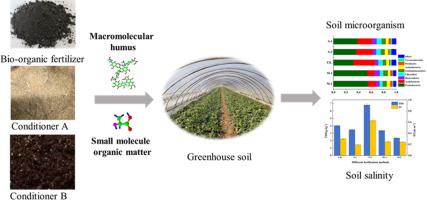Applied Soil Ecology ( IF 4.8 ) Pub Date : 2021-04-13 , DOI: 10.1016/j.apsoil.2021.104006 Lin Zhu , Xuan Jia , Mingxiao Li , Yong Wang , Junping Zhang , Jiaqi Hou , Xinlin Wang

|
Secondary soil salinization is a major factor limiting crop production in greenhouses. The lack of availability of fertilizer is a key problem that restricts improvement of saline soil. The present study investigated the effectiveness of bio-organic fertilizer that alleviated the stress of salt in greenhouse saline soil using a variety of fertilization methods. Five fertilization methods were compared, including bio-organic fertilizer (S-1), excess bio-organic fertilizer (S-2), bio-organic fertilizer with a single soil conditioner (M-1), bio-organic fertilizer with two soil conditioners (M-2), and no fertilizer (CK). The results indicate that the co-application of bio-organic fertilizer and soil conditioner is an optimal treatment for enhanced fertilizer efficiency, reduced salinity, improved soil structure, and optimization of microbial community function. Total dissolved salt after application of M-1 and M-2 treatments was 16.39% and 41.36% lower than that of CK (P < 0.01), respectively. Conversely, total dissolved salt after S-2 was 1.95-fold higher than that of CK when using excess bio-organic fertilizer. The use of S-2 also resulted in increased EC, in addition to the quantity of Na+ and Ca2+. Co-application of bio-organic fertilizer and soil conditioner treatments (M-1 and M-2) increased the quantity of organic matter 1.27 and 1.50-fold, respectively, in addition to increasing the quantity of humus in both treatments (P < 0.05). The stability of aggregates in M-1 and M-2 increased significantly (P < 0.01). Furthermore, compared with CK, Proteobacteria, Bacteroidetes, and Firmicutes bacteria were significantly enriched (P < 0.05) after M-1 and M-2, whereas Chloroflexi and Acidobacteria declined significantly (P < 0.05). Therefore, the present study suggests that co-application of bio-organic fertilizer and soil conditioner could be used to mitigate salt accumulation, and provides a solution for the disposal of organic waste.
中文翻译:

食品废物发酵产生的生物有机肥料和土壤改良剂在山东省温室盐渍土壤上的协同效应
次生土壤盐渍化是限制温室作物产量的主要因素。缺乏肥料是限制盐碱土壤改良的关键问题。本研究调查了生物有机肥料通过多种施肥方法缓解温室盐渍土壤中盐分胁迫的有效性。比较了五种施肥方法,包括生物有机肥(S-1),过量生物有机肥(S-2),带单一土壤改良剂的生物有机肥(M-1),带两种土壤的生物有机肥调节剂(M-2),无肥料(CK)。结果表明,生物有机肥和土壤改良剂的共同应用是提高肥料利用率,降低盐分,改善土壤结构,和优化微生物群落功能。施用M-1和M-2处理后的总溶盐比CK分别低16.39%和41.36%(P <0.01)。相反,当使用过量的生物有机肥料时,S-2后的总溶解盐量比CK高1.95倍。除了Na +和Ca 2+的数量外,使用S-2还可以提高EC 。生物有机肥料和土壤改良剂处理(M-1和M-2)的共同施用分别增加了腐殖质的数量,有机物的数量分别增加了1.27倍和1.50倍(P <0.05) )。团聚体在M-1和M-2中的稳定性显着提高(P <0.01)。此外,与CK相比,Proteobacteria,Bacteroidetes和Firmicutes M-1和M-2后细菌显着富集(P <0.05),而弯曲挠菌和嗜酸细菌显着下降(P <0.05)。因此,本研究表明,生物有机肥和土壤改良剂的共同应用可用于减轻盐分的积累,并为有机废物的处置提供解决方案。



























 京公网安备 11010802027423号
京公网安备 11010802027423号